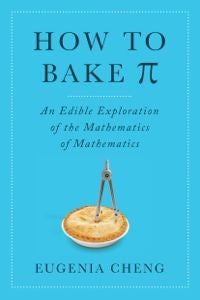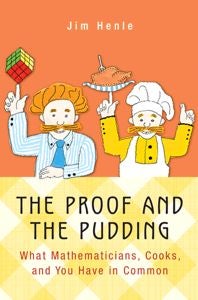This article was published in Scientific American’s former blog network and reflects the views of the author, not necessarily those of Scientific American
This spring delivered not one but two books containing both mathematics and recipes to my doorstep. The first, How to Bake Pi by Eugenia Cheng, is “an edible exploration of the mathematics of mathematics,” category theory. The second, The Proof and the Pudding by Jim Henle, is about the many parallels between cooking and math: both have practical aspects, but beyond satiating hunger or balancing checkbooks, they're fun. Both books are dotted with recipes, and I found both of them delightful.

Image: Basic Books.
How to Bake Pi
On supporting science journalism
If you're enjoying this article, consider supporting our award-winning journalism by subscribing. By purchasing a subscription you are helping to ensure the future of impactful stories about the discoveries and ideas shaping our world today.
Eugenia Cheng is a math professor at the University of Sheffield and the University of Chicago, and she spent this past semester visiting the School of the Art Institute of Chicago. As if that's not enough, she's also a concert pianist. Her book, a very gentle introduction to the main ideas of mathematics in general and category theory in particular, exudes enthusiasm for mathematics, teaching, and creative recipes. Category theory is dangerously abstract, but Cheng's writing is down-to-earth and friendly. She's the kind of person you'd want to talk to at a party, whether about math, food, music, or just the weather.
How to Bake Pi is filled with analogies between cooking and math. For example, what is an ingredient? In the "Axiomatization" chapter, Cheng gives a recipe for jaffa cakes where the first ingredient is "small round flat plain cakes." Some people might start that way, but some might start by making the cakes out of flour, eggs, sugar, and butter. Some might start by grinding the wheat or milking the cow. None of these ways are wrong, but they use different ingredients. Math's ingredients are axioms. It's OK to choose different axioms, but you might get a different product or use a different method in the end.
Math is hard. If anything, most mathematicians I know believe this more fervently than other people. But Cheng has a different perspective. In a section called “Why Math is Easy and Life is Hard,” she writes,
It is a truth universally acknowledged that mathematics is difficult. Or at least so it seems, based on the number of times I tell someone I’m a mathematicians only for them to respond, "Wow, you must be really clever."
This is one of the great myths of mathematics. I’m now going to take the bold step—perhaps the rash step—of exploding it. This is a bit like the Masked Magician, whose TV show explained how magic tricks work, with the result that he was vilified by the Magical community. Nevertheless, I am going to show that mathematics is easy, and in fact that it is precisely "that which is easy."
First, I’d better make clear what I mean by "easy,".… Something is easy if it is attainable by logical thought processes. That is, without having to resort to imagination, guesswork, luck, gut feeling, convoluted interpretation, leaps of faith, blackmail, drugs, violence, and so on.
By contrast, life is hard. That is, it involves things that are not attainable by logical thought processes. This can be seen either as a temporarily necessary evil or an eternally beautiful truth.
It’s an interesting perspective, and she explains it convincingly. The danger in saying that math is easy is that it’s a good way to alienate the many people who struggle with math, but Cheng doesn’t come off as arrogant or dismissive of those who find math difficult. Instead, she encourages them to think about math—and difficulty—from a different perspective. Cheng's cheerful, accessible writing and colorful examples make How to Bake Pi an entertaining introduction to the fundamentals of abstract mathematical thinking.
The Proof and the Pudding
Jim Henle, a math professor at Smith College, explains his book this way: "if you look at mathematics and gastronomy the right way, they are amazingly alike." But there's more.

Image: Princeton University Press.
This book has a deeper purpose. Underneath the propositions and the pastry, the real subject of the book is fun.
There are reasons to do mathematics and there are reasons to cook. But in both fields, the chief motivation is pleasure. This is not hard to see on the gastronomic side, but mathematicians also, surprisingly, are hedonists. They’re out for a good time.
The Proof and the Pudding isn’t your typical “math is fun” book filled with slick tricks and puzzles, although there are some of those. Instead, a lot of it is about how the journey is fun, even if it’s not a straight line to the answer. He writes about the enjoyment he finds even when he fails and about the way those failures can help sharpen mathematical thinking.
My favorite example is from the section about Euler’s polyhedron formula. This famous formula in mathematics (there’s a whole book about it) describes a relationship between the numbers of vertices, edges, and faces of a polyhedron. It can be summarized by V-E+F=2. Or can it? Henle includes pictures of polyhedra that don’t follow that rule and shows how each example helps us understand exactly what conditions are required for the relationship to hold. Henle writes, “Over and over the examples came. Each time, the statement of the theorem was refined. Always there was a true theorem at the center.”
Henle’s first tip for problem solving in either math or cooking is “Don’t worry, just try something.” An important later addendum is to keep trying. Neither cooking nor math is an innate, unlearnable skill. If you keep at it, you will make progress. I think the best thing about Henle’s book is the way it can inspire any of us who have been stuck on a math problem not to see our struggle as failure.
If you spend hours/days/weeks/years using my method on a problem without success, you haven’t wasted your time because
- You had fun (I hope).
- You grew intellectually.
- You now understand the problem at a deeper level.
Those lessons are not specific to either math or cooking. If you want to get good at any creative endeavor, you have to spend time being bad at it, making mistakes and running into dead ends. Henle helps us have fun in those dead ends.